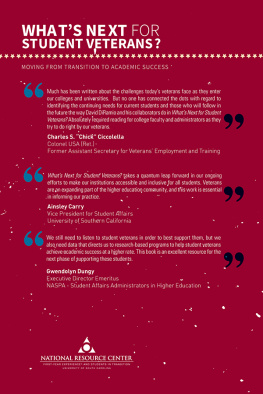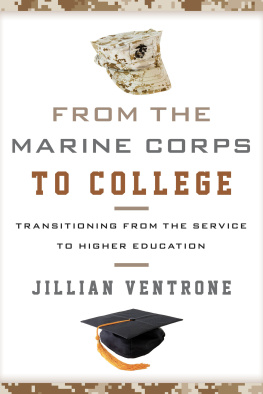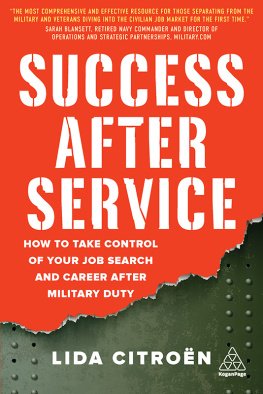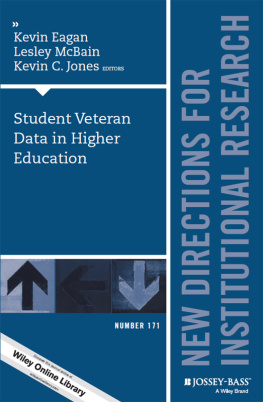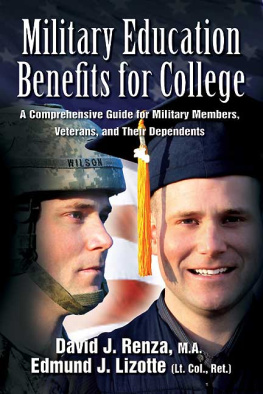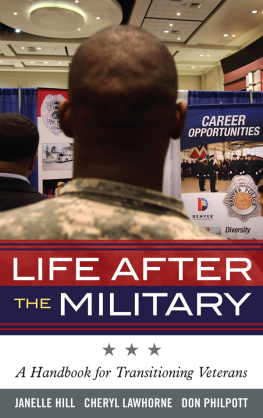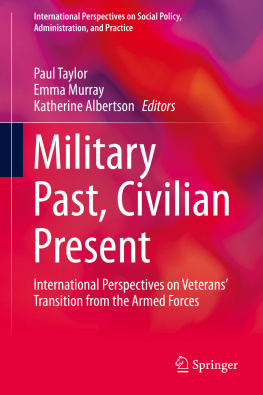

Cite as:
DiRamio, D. (Ed.). (2017). Whats next for student veterans? Moving from transition to academic success. Columbia, SC: University of South Carolina, National Resource Center for The First-Year Experience & Students in Transition.
Copyright 2017 University of South Carolina. All rights reserved. No part of this work may be reproduced or copied in any form, by any means, without written permission of the University of South Carolina.
ISBN: 978-1-942072-10-2
Published by:
National Resource Center for The First-Year Experience
and Students in Transition
University of South Carolina
1728 College Street, Columbia, SC 29208
www.sc.edu/fye
The First-Year Experience is a service mark of the University of South Carolina. A license may be granted upon written request to use the term The First-Year Experience. This license is not transferable without written approval of the University of South Carolina.
Production Staff for the National Resource Center:
Project Manager: Tracy L. Skipper, Assistant Director for Publications
Design and Production: Allison Minsk, Graphic Artist
External Reviewers: Sonya Joseph, Assistant Vice President of Student Affairs, Valencia College
Phillip Morris, Program Director, Office of Veteran and Military Student Affairs, University of ColoradoColorado Springs
Library of Congress Cataloging-in-Publication Data
Names: DiRamio, David C., editor of compilation.
Title: Whats next for student veterans? : moving from transition to academic success / David DiRamio, editor.
Description: Columbia, SC : National Resource Center for The First-Year Experience and Students in Transition, University of South Carolina, [2017] | Includes bibliographical references and index.
Identifiers: LCCN 2017025521 (print) | LCCN 2017047585 (ebook) | ISBN 9781942072157 (Ebrary) | ISBN 9781942072164 (EPub) | ISBN 9781942072102 (pbk. : alk. paper)
Subjects: LCSH: VeteransEducation (Higher)--United States. | VeteransEducationUnited States.
Classification: LCC UB357 (ebook) | LCC UB357 .W52 2017 (print) | DDC 378.1/9826970973--dc23
LC record available at https://lccn.loc.gov/2017025521

The National Resource Center for The First-Year Experience and Students in Transition was born out of the success of University of South Carolinas much-honored University 101 course and a series of annual conferences on the first-year experience. The momentum created by the educators attending these early conferences paved the way for the development of the National Resource Center, which was established at the University of South Carolina in 1986. As the National Resource Center broadened its focus to include other significant student transitions in higher education, it underwent several name changes, adopting the National Resource Center for The First-Year Experience and Students in Transition in 1998.
Today, the Center collaborates with its institutional partner, University 101 Programs, in pursuit of its mission to advance and support efforts to improve student learning and transitions into and through higher education. We achieve this mission by providing opportunities for the exchange of practical and scholarly information as well as the discussion of trends and issues in our field through convening conferences and other professional development events, such as institutes, workshops, and online learning opportunities; publishing scholarly practice books, research reports, a peer-reviewed journal, electronic newsletters, and guides; generating, supporting, and disseminating research and scholarship; hosting visiting scholars; and maintaining several online channels for resource sharing and communication, including a dynamic website, listservs, and social media outlets. The National Resource Center serves as the trusted expert, internationally recognized leader, and clearinghouse for scholarship, policy, and best practice for all postsecondary student transitions.
Institutional Home
The National Resource Center is located at the University of South Carolinas (UofSC) flagship campus in Columbia. Chartered in 1801, the Universitys mission is twofold: (a) to establish and maintain excellence in its student population, faculty, academic programs, living and learning environment, technological infrastructure, library resources, research and scholarship, public and private support, and endowment; and (b) to enhance the industrial, economic, and cultural potential of the state. The Columbia campus offers 324 degree programs through its 15 degree-granting colleges and schools. In fiscal year 2015, faculty generated $243 million in funding for research, outreach, and training programs. UofSC is one of only 32 public universities receiving both Research and Community Engagement designations from the Carnegie Foundation.

David Blair
Chapter 1
Data-Driven Inquiry, Servicemembers Perspectives, and Redefining Success
Corri Zoli, Rosalinda Maury, and Daniel L. Fay
Chapter 2
Opportunity, Inequity, and Americas Story: Intersections With Military-Connected Individuals in Higher Education
Andrew Q. Morse and Dani Molina
Chapter 3
The Journey or the Destination: Exploring Engagement Patterns of Disabled Student Veterans
Amanda Kraus, R. Cody Nicholls, and James S. Cole
Chapter 4
Mental Health and Academic Functioning of Student Servicemembers and Veterans in Higher Education: The Importance of Social Support
Adam E. Barry, Shawn D. Whiteman, and Shelley MacDermid Wadsworth
Chapter 5
Serving Those Who Served: Promising Institutional Practices and Americas Military Veterans
Dani Molina and Tanya Ang
Chapter 6
Navigating Toward Academic Success: Peer Support for Student Veterans
Michelle Kees, Brittany Risk, Chrysta Meadowbrooke, Jane L. Spinner, and Marcia Valenstein
Chapter 7
Completing the Mission II: A Study of Veteran Students Progress Toward Degree Attainment in the Post-9/11 Era
Wendy A. Lang and Tom ODonnell
Chapter 8
Academic Outcomes and the Million Records Project
Chris Andrew Cate
Chapter 9
Where Do They Fit? Applying the Conceptual Model of Nontraditional Undergraduate Student Attrition to Student Veterans
Ryan L. Van Dusen
Chapter 10
Essential Practices for Student Veterans in the California Community College System
Wayne K. Miller II
Chapter 11
Whats Next? Charting the Course Before Moving Off the Radar
David DiRamio

Tables
Figures

One of the greatest pleasures of serving todays student veterans is to see them progress year-by-year through a program of major study, take the life-changing walk across the stage to receive a degree, and move into the workforce well prepared for the next chapter in life. As those of us who work with this unique student population know, a student veterans path through the higher education landscape can be strewn with potential academic and personal landmines. For example, most of these students have been out of school for years, some are married with children, others face formidable challenges associated with physical and psychological injuries, and many are likely to have a combination of several challenges.
Next page
